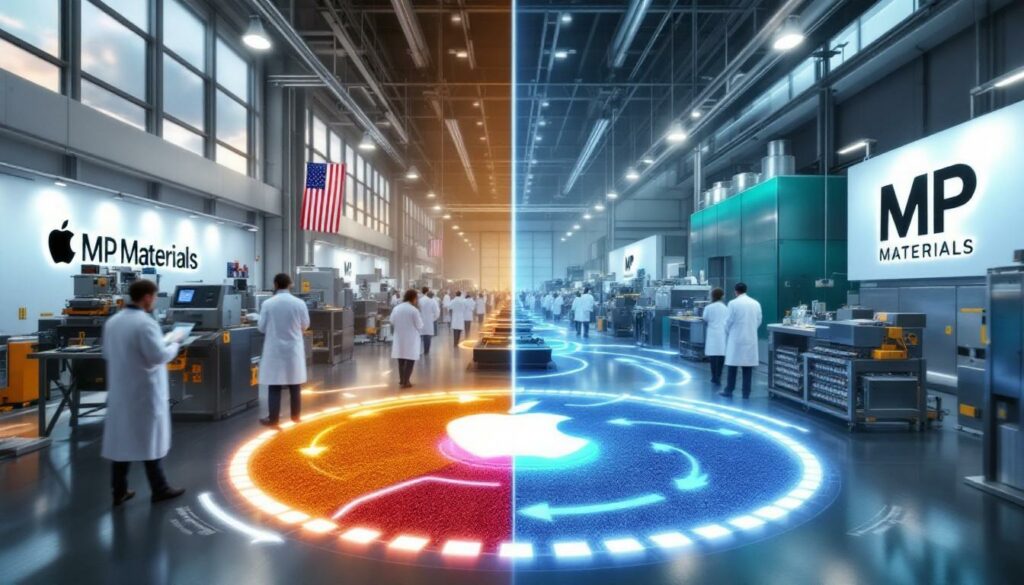MP Materials and Apple: Pioneering 100% Recycled Rare Earth Magnets
Rare earth magnets have become essential components in modern technology, from smartphones to electric vehicles. A groundbreaking partnership between MP Materials and Apple aims to revolutionize how these critical materials are sourced and manufactured, creating a more sustainable future for tech manufacturing.
What Is the MP Materials and Apple Partnership?
MP Materials and Apple have established a landmark $500 million agreement to develop and supply rare earth magnets manufactured entirely from recycled materials. This collaboration, announced in July 2025, represents a significant advancement in sustainable technology manufacturing and strengthens domestic supply chain resilience in the United States.
$500 Million Agreement for Sustainable Magnets
The partnership's core focus is creating a closed-loop system for rare earth magnets, with MP Materials producing these components at their Fort Worth, Texas facility (known as "Independence") using recycled materials processed at their Mountain Pass site in California.
James Litinsky, CEO of MP Materials, emphasized: "This collaboration deepens our vertical integration, strengthens supply chain resilience, and reinforces America's industrial capacity at a pivotal moment" for both companies and the broader technology manufacturing sector.
The agreement's structure involves a sophisticated vertical integration approach:
- Recycled rare earth materials are processed at Mountain Pass
- Refined materials are transferred to the Independence Facility
- Finished magnets are manufactured to Apple's specifications
- Products are delivered for integration into Apple devices
Five Years of Collaborative Development
This agreement builds on nearly five years of rigorous collaborative development between the two companies. During this extended period (2020-2025), they jointly piloted recycling technologies and refined processes to meet Apple's exacting performance standards.
The collaborative R&D phase was critical to overcoming the technical challenges associated with rare earth recycling, including:
- Maintaining consistent magnetic strength in recycled materials
- Ensuring recycled magnets meet Apple's miniaturization requirements
- Developing efficient separation processes for mixed materials
- Creating quality control protocols for recycled inputs
This partnership represents the largest U.S.-based rare earth recycling initiative for consumer electronics, combining Apple's precise design specifications with MP Materials' extraction and processing expertise.
How Will the Recycled Magnet Production Work?
The recycling process leverages MP Materials' existing infrastructure while adding significant new capabilities specifically designed for processing recycled inputs.
Mountain Pass Recycling Expansion
To fulfill the agreement, MP Materials will construct a dedicated commercial-scale recycling line at their Mountain Pass facility in California. This new infrastructure represents a significant portion of the $500 million investment and will be capable of processing diverse input materials, including:
- Magnet manufacturing scrap from industrial processes
- Components recovered from end-of-life consumer electronics
- Production waste from technology manufacturing
- Post-consumer rare earth materials from various sources
The recycling line employs a proprietary hydrometallurgical process developed during the five-year collaborative phase, which separates rare earth elements with minimal cross-contamination—a critical factor in maintaining magnetic performance.
The Independence Facility's Role
The recycled materials processed at Mountain Pass will then be transferred to MP's Fort Worth facility for final manufacturing into finished magnets. This vertical integration allows MP Materials to:
- Control the entire production process from recycled inputs to finished products
- Maintain strict quality standards throughout the manufacturing cycle
- Reduce transportation emissions compared to international supply chains
- Ensure security and transparency throughout the production process
The Fort Worth facility has undergone significant upgrades to accommodate the specific requirements of producing magnets from recycled materials, including enhanced testing capabilities to verify performance characteristics.
Production Timeline and Scale
According to the announcement, the production schedule follows an ambitious but measured rollout:
- Initial magnet shipments to Apple will begin in 2027
- Production will scale progressively to support hundreds of millions of devices
- By 2028, the operation is expected to supply >30% of Apple's annual rare earth magnet requirements
- Full production capacity aligns with the commissioning of MP's "10X Facility" in 2028
This gradual scaling approach allows for optimization of processes and ensures consistent quality as production volumes increase.
Why Are Recycled Rare Earth Magnets Important?
The transition to recycled rare earth magnets addresses multiple critical challenges in technology manufacturing and resource management.
Critical Components in Modern Technology
Rare earth magnets—primarily neodymium-iron-boron (NdFeB) compounds—are essential to countless modern technologies due to their exceptional magnetic strength relative to size. These components power:
- Speakers, haptic engines, and camera stabilizers in smartphones and tablets
- Motors in electric vehicles, robots, and drones
- Generators in wind turbines and hydroelectric systems
- Sensors and actuators in medical devices
- Hard disk drives and cooling fans in computers
The ubiquity of these magnets in modern devices makes them a critical resource for technology manufacturers, with demand consistently growing at 8-10% annually.
Environmental and Supply Chain Benefits
The recycling initiative offers several significant advantages over traditional mining and processing:
Environmental Impact Reduction
- 40-60% energy reduction per kilogram of rare earth elements compared to primary mining operations
- Decreased water usage and elimination of mining-related habitat disruption
- 50-70% lower carbon footprint compared to traditional extraction methods
- Minimization of toxic waste from processing virgin materials
- Reduction in e-waste through component recovery and reuse
"Recycling rare earth magnets represents one of the highest-impact sustainability initiatives for electronics manufacturing, as it addresses both input materials and end-of-life waste management solutions simultaneously." — Environmental analysis from MP Materials
Supply Chain Security
- Decreases dependence on foreign rare earth sources, which currently account for approximately 80% of U.S. rare earth consumption
- Creates resilience against supply disruptions due to geopolitical tensions
- Establishes domestic production capabilities for strategically important materials
- Reduces vulnerability to price volatility in global rare earth markets
- Shortens supply chains, decreasing transportation emissions and delivery timelines
The combination of environmental benefits and supply chain security makes recycled rare earth magnets a strategic priority for both companies and the broader technology sector.
How Does This Fit Into Broader Strategic Initiatives?
The Apple agreement represents one component of MP Materials' comprehensive strategy to transform rare earth production in the United States.
Alignment with Department of Defense Partnership
This Apple agreement strategically complements MP Materials' recently announced public-private partnership with the U.S. Department of Defense. That multi-billion-dollar package aims to boost domestic magnet production through the development of a "10X Facility"—a second plant scheduled for commissioning in 2028 that will increase MP's U.S. production capacity to 10,000 tons annually.
The complementary nature of these partnerships creates significant synergies:
- The DoD partnership provides infrastructure funding that benefits both initiatives
- Technology developed for Apple's recycling can be applied to defense applications
- Combined production volumes create economies of scale
- Shared R&D efforts accelerate innovation in recycling techniques
These dual investments position MP Materials as the cornerstone of U.S. rare earth production and processing capacity.
Strategic Implications for U.S. Manufacturing
The combined initiatives represent significant steps toward reshoring critical mineral processing and reducing dependence on foreign suppliers. Key strategic benefits include:
- Industrial capacity development: Building domestic expertise in advanced material processing
- Supply chain resilience: Creating redundant sourcing options for critical components
- Innovation leadership: Establishing the U.S. as a leader in sustainable materials production
- National security enhancement: Ensuring access to materials essential for defense technologies
- Circular economy advancement: Creating a model for closed-loop recycling breakthrough in high-tech manufacturing
By 2030, these initiatives are projected to enable the U.S. to produce approximately 20% of global recycled rare earth output, a significant shift from current near-total dependence on imports.
What Are the Technology and Innovation Aspects?
The partnership between MP Materials and Apple extends beyond simple supply agreements to include significant collaborative innovation.
Joint Innovation Commitments
The agreement includes provisions for ongoing collaboration to advance several key technological areas:
- Recycling efficiency improvements: Developing methods to increase material recovery rates
- Separation technology enhancement: Refining processes to maintain higher purity in recycled materials
- Performance optimization: Ensuring recycled magnets match or exceed virgin material performance
- Miniaturization capabilities: Adapting recycling processes to support increasingly compact device designs
- Energy reduction: Decreasing the energy intensity of recycling operations
This joint innovation approach leverages Apple's expertise in product design and performance requirements with MP Materials' knowledge of rare earth processing and magnet manufacturing.
Technical Challenges and Solutions
Producing high-performance magnets from recycled materials presents several complex technical challenges that the partnership has addressed through innovative approaches:
Material Recovery Complexity
-
Challenge: Separating rare earth elements from complex devices with multiple alloys and contaminants
-
Solution: MP's proprietary hydrometallurgical process achieves 95%+ rare earth recovery from mixed inputs
-
Challenge: Maintaining material purity through multiple recycling processes
-
Solution: Advanced spectroscopic monitoring ensures impurity levels remain below 0.5% throughout processing
-
Challenge: Ensuring consistent quality from variable input streams
-
Solution: AI-powered sorting systems identify and classify recycled materials before processing
Performance Requirements
-
Challenge: Meeting Apple's requirement for magnetic strength exceeding 50 MGOe (megagauss-oersteds)
-
Solution: Precision alloying processes restore optimal neodymium-iron-boron ratios in recycled materials
-
Challenge: Ensuring durability and temperature stability in compact devices
-
Solution: Specialized sintering techniques enhance coercivity in recycled magnets
-
Challenge: Maintaining ±2% magnetic strength variance across production batches
-
Solution: Continuous testing protocols verify performance at multiple manufacturing stages
These technical innovations establish new benchmarks for what's possible in rare earth recycling, potentially influencing standards across the technology sector.
What Are the Market and Industry Implications?
This partnership has significant implications for both the rare earth market and the broader technology manufacturing sector.
Setting New Industry Standards
The MP Materials-Apple agreement establishes new benchmarks in several key areas:
- Scale of implementation: First 100% recycled magnet supply chain for mass-market consumer electronics
- Performance standards: Demonstrating recycled magnets can meet exacting specifications
- Vertical integration: Proving the viability of end-to-end domestic production
- Commercial viability: Establishing recycling as economically sustainable at scale
- Corporate commitment: Showing long-term investment in circular material flows
These precedents may influence how other technology companies approach material sourcing and sustainability initiatives, potentially accelerating adoption of similar recycling programs.
Potential Market Impacts
The agreement could influence broader market dynamics in several ways:
- Creation of recycled material markets: Establishing price points and specifications for recycled rare earths
- Supplier expectations: Raising sustainability standards for technology component manufacturers
- Investment signals: Encouraging capital allocation toward recycling infrastructure
- Policy influence: Demonstrating the viability of domestic production to policymakers
- Consumer awareness: Highlighting material sourcing as a differentiating factor in electronics
Market analysts project that this initiative could help shift 15-20% of global rare earth demand toward recycled sources by 2030, representing a significant market transformation.
What Are the Frequently Asked Questions About This Partnership?
How Does Rare Earth Recycling Compare to Primary Mining?
Recycling rare earth materials offers significant advantages over primary mining, including:
- Energy efficiency: 40-60% less energy consumption per kilogram of material
- Environmental impact: Elimination of mining-related habitat disruption and acid drainage
- Water conservation: 50-70% reduction in water usage compared to conventional extraction
- Emissions reduction: Substantially lower carbon footprint across the production cycle
- Waste reduction: Decreased tailings and processing chemicals compared to mining operations
While recycling presents its own technical challenges, particularly in separation and purification, the MP Materials-Apple partnership demonstrates these can be overcome at commercial scale.
Will This Affect Consumer Pricing for Apple Products?
The integration of recycled materials is unlikely to significantly impact consumer pricing for several reasons:
- The agreement represents a long-term strategic investment rather than a short-term cost increase
- Recycling costs are expected to decrease as processes scale and efficiencies improve
- Rare earth materials represent a relatively small portion of overall device costs
- Supply chain security benefits offset some of the initial investment costs
- Apple's sustainability strategy absorbs premium costs to achieve environmental goals
According to Apple's newsroom, the company has historically maintained consistent pricing while increasing recycled material content across its product lines, suggesting this partnership will follow a similar approach.
How Does This Compare to Other Rare Earth Recycling Efforts?
This partnership represents one of the largest and most comprehensive rare earth recycling initiatives announced to date:
| Company/Initiative | Scale | Focus | Vertical Integration |
|---|---|---|---|
| MP Materials-Apple | Commercial (hundreds of millions of devices) | NdFeB magnets for consumer electronics | Full (recycling to finished magnets) |
| HyProMag (UK) | Pilot/small commercial | Hydrogen processing of magnet scrap | Partial (processing only) |
| Urban Mining Company | Small commercial | Recycled magnets for industrial applications | Partial (magnet manufacturing) |
| Redwood Materials | Large commercial | Battery materials (including some rare earths) | Partial (material recovery) |
| Ucore Rare Metals | Pilot | Solvent extraction technology | Minimal (technology development) |
The MP Materials-Apple partnership distinguishes itself through its scale, complete vertical integration, and focus on high-performance consumer electronics applications.
What Percentage of Apple's Rare Earth Needs Will This Satisfy?
While specific percentages haven't been disclosed in exact terms, the announcement indicates the partnership will scale to support "hundreds of millions of devices," suggesting a substantial portion of Apple's rare earth requirements will eventually be met through this recycled source.
Based on Apple's current production volumes and the planned scaling of the recycling operation:
- Initial production (2027): Likely supporting 10-15% of Apple's rare earth magnet needs
- Mid-term production (2028-2029): Expanding to approximately 30% of requirements
- Long-term potential (2030+): Possibly exceeding 50% with process optimizations
The gradual scaling allows for quality control and process refinement while steadily increasing the proportion of recycled content in Apple products.
Future Outlook for Rare Earth Recycling
The MP Materials-Apple partnership serves as a catalyst for broader transformation in how rare earth materials are sourced, processed, and recovered.
Potential for Industry Expansion
This initiative creates a blueprint for similar programs across the technology sector:
- Technology transfer potential: Processes developed could be adapted for other electronics manufacturers
- Infrastructure development: Recycling facilities could expand to accept materials from multiple sources
- Standards creation: Quality specifications for recycled materials could become industry benchmarks
- Supply chain integration: Collection and sorting systems could evolve to better capture rare earth components
- Consumer expectations: End users may increasingly expect recycled content in technology products
As recycling technologies mature and scale, costs are projected to decrease, potentially making recycled rare earth materials economically competitive with primary sources even without sustainability premiums.
Technological Development Trajectory
The partnership is expected to drive continued innovation in recycling processes:
- 2026-2027: AI-driven automated sorting and disassembly systems
- 2027-2028: Enhanced hydrometallurgical processes with higher recovery rates
- 2028-2029: Closed-loop EV motor recycling integration
- 2029-2030: Direct magnet-to-magnet recycling without full material breakdown
These innovations will likely improve recovery rates from complex devices, reduce processing costs and energy requirements, expand the range of recoverable materials, and enable higher-performance recycled magnets.
Policy and Regulatory Considerations
The success of this initiative may influence future policy developments in several areas:
- Extended producer responsibility: Regulations requiring manufacturers to manage end-of-life products
- Recycled content mandates: Requirements for minimum percentages of recycled materials
- Critical minerals strategies: Government support for domestic recycling infrastructure
- R&D incentives: Funding for advanced recycling technologies
- Trade policies: Tariff structures that recognize recycled material origins
Policy frameworks that support rare earth recycling could accelerate the transition to a more circular economy for these critical materials, further enhancing the impact of private sector initiatives like the MP Materials-Apple partnership.
Summary: Transforming the Rare Earth Supply Chain
The landmark partnership between MP Materials and Apple represents a significant advancement in creating a more sustainable and secure supply chain for critical rare earth magnets. By establishing a domestic, recycling-based production system, the companies are addressing environmental concerns while strengthening U.S. manufacturing capabilities in strategic minerals reserve.
Key takeaways from this initiative include:
- Environmental benefits: Substantially reduced energy consumption, water usage, and carbon emissions compared to traditional mining and processing
- Supply chain security: Decreased dependence on foreign sources for critical materials used in hundreds of millions of devices
- Technological innovation: Development of advanced recycling processes that maintain high performance standards
- Economic impact: Creation of domestic manufacturing capabilities and associated employment opportunities
- Strategic alignment: Complementary relationship with national security priorities and defense initiatives
- Industry leadership: Establishment of new benchmarks for sustainable materials sourcing
Looking for the Next Big Mineral Discovery?
Stay ahead of the market with Discovery Alert's proprietary Discovery IQ model, delivering real-time notifications of significant ASX mineral discoveries and transforming complex data into actionable investment insights. Explore why historic discoveries generate substantial returns by visiting Discovery Alert's dedicated discoveries page and begin your 30-day free trial today.




